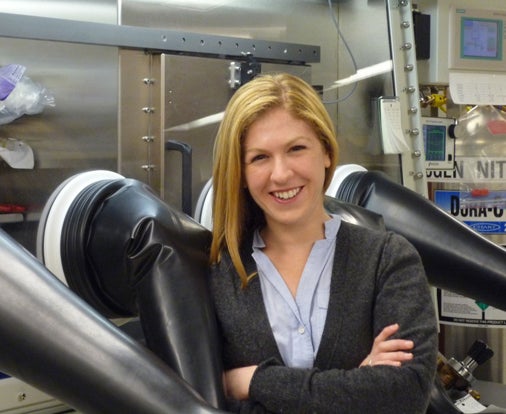Scaled to size: Chemistry professor’s research finds the universe within the microscopic
In Jill Millstone ’s world, things do not start to get interesting until they are invisible to the naked eye. Then all hell breaks loose.
’s world, things do not start to get interesting until they are invisible to the naked eye. Then all hell breaks loose.
As an assistant professor in the Department of Chemistry, Millstone’s research focuses on the nanometer length scale—“so, larger than an atom and smaller than a bacteria,” she explains. At that size, everything you thought you knew about the most common elements goes right out the window, and as a scientist, she could not be more excited.
“What interests me about this is that you have normal materials that we see every day—silver, iron, gold—materials that we’re very familiar with, (that) have been known for centuries,” Millstone says. “When you make them very small, they start to have properties that they don’t have on the bulk scale,” which refers to the scale familiar to most people.
For example, on a large scale, silver looks the same, tarnishes the same, and conducts electricity about the same, regardless of whether it is shaped like a spoon or a fork. But a nanoparticle of silver that is shaped like a sphere differs from one shaped like a triangle; one is yellow, the other is blue. They interact with light differently.
“The way I think about this is that it’s kind of like you have the periodic table, except that now it’s three dimensional,” Millstone says. “Now, you’ve gone crazy. You’ve discovered a whole new world of materials from the materials we already had.”
Millstone arrived at the Dietrich School of Arts and Sciences in August 2011, lured by the appeal of the other faculty working in the chemistry department. Pitt’s professors were invested in making their department a fine place to work, collaborating scientifically, and supporting each other’s efforts.
“These are people who are not only doing great science, but they are really great people: Warm, driven to make science and science education better,” she says.
She spent much of her first summer at Pitt in her office working on a grant application for the National Science Foundation’s prestigious Faculty Early Career Development (CAREER) Program, which honors junior faculty who exemplify the role of teacher-scholars through their integration of education and research.
Few applicants are awarded the five-year grant on their first try, but Millstone hoped to receive feedback from the NSF that would help her future efforts. She was shocked when the program officer called her in December 2012 to tell her she had won.
“I didn’t really understand what he was saying, at first,” she recalls. She asked him: “I just want to be crystal clear: Are you actually saying I got it?”
The program officer laughed, and confirmed that, indeed, she had.
“It’s a vote of confidence,” acknowledges Millstone, who will use the grant to move the six graduate students in her lab into full-time research. (She also employs two undergraduates and a postdoctoral researcher.) “It makes you feel like, ‘Good, I’m working on something that we all care about.’”
The nanoparticles with which she works have seemingly endless applications. A paper that was published in April discusses possible uses for gold and copper alloys that are two to three nanometers wide, or the size of side-by-side strands of DNA. These tiny particles emit light in the near-infrared region of the spectrum, at which the human body does not absorb much radiation.
Millstone’s lab is collaborating with faculty in the University of Pittsburgh Medical Center’s radiology unit to see if the particles are visible inside mice. The hope is that they will eventually lead to a less-toxic tracking mechanism for medical imaging such as MRI or PET scans.
“The moral of that story, from our perspective, is when you learn how to make a nanoparticle well, you discover things you don’t expect,” she notes.
It is a concept that Millstone hopes to convey to her students. As an undergraduate, she majored in both chemistry and English, and her communication style and obvious enthusiasm for her work are infectious. While talking about the synthesis of metallic nanoparticles, for example, she interrupts herself: “My favorite thing to do, honestly, is talk about science,” she laughs.
Like her career, her field is young—only about 10 years old or so—and that, too, energizes her.
“No one really wants to get up in the morning unless they’re doing something that contributes. But what makes it extremely exciting is the properties we discover often have extremely important applications,” she says. “We’re a little like explorers or astronauts, always seeing things that haven’t been seen before. It’s pretty fun.”
